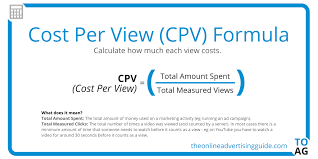We’ll figure out what cost per view is, how it differs from other advertising indicators, and which advertisers use CPV and for what purpose.
What is CPV
How Pay Per View Works
CPV calculation formula
Advantages and Disadvantages of the CPV Model
What is the difference between CPV and CPM, CTR, CPA and CPS
How and when it is used in advertising
Expert advice
What is CPV
Table of Contents
CPV (cost per view) is the average cost that an advertiser pays for users to view their ads. The indicator is used when launching campaigns with videos on various platforms, such as Yandex services and partner sites of the Yandex Advertising Network (YAN).
In marketing, the CPV value is not a fixed figure, it depends on many factors, including: the advertiser’s budget, product category, duration of the video placement and its quality. The lower the indicator, the more video views the advertiser will receive for their budget. A high cost per view means that there is strong competition in the niche or the video is not in high demand. Low CPV means that the ad is of interest to users.
How Pay Per View Works
In the personal account of the advertising system, you can independently set the maximum CPV, then the cost of viewing will not exceed this value. The higher the CPV, the better the sites that the system will select for showing the video will be. It is important not to overestimate the CPV, otherwise the volume of impressions and coverage of the campaign may be small.
The budget should not be spent on users who are not interested in the ad, so the view for which the advertiser pays must meet one of three conditions:
1.The user watches the entire commercial if it lasts up to 30 seconds.
2.The user watches at least 30 seconds of the video if it lasts longer than 30 seconds.
3.The user follows the link placed in the video.
After launching a campaign, the average CPV for each video can be viewed in the advertising system report.
CPV calculation formula
The CPV calculation for a current or completed advertising campaign is calculated using the formula.
Let’s say 1 million rubles were allocated for video advertising, and by the end of the campaign the video was viewed by 1.25 million users. In this case, the CPV calculation will be as follows: 1,000,000 / 1,250,000 = 0.8 rubles . That is, each ad view cost almost one ruble.
Typically, CPV varies between 0.16 rubles and 1 ruble, which means that the indicator from our example can be considered high. A more accurate estimate of cost per view can be achieved by comparing with previous campaigns and benchmarks — CPV statistics published by major advertising agencies.
It is not necessary to calculate CPV yourself: some advertising systems show the cost of each view. For example, Yandex Direct has a Campaign Planner tool – there you can specify the budget and campaign type, and the system will offer the optimal cost per view.
You can learn how to analyze and manage CPV, as well as calculate and use other advertising campaign metrics in promotion on the Traffic Manager course.
Advantages and Disadvantages of the CPV Model
Let’s consider the pros and cons of this indicator.
✅Pros
❌Cons
The advertiser pays only for the audience that found the ad interesting. If a person is not interested in the video, he will simply click the “Skip” button or close the page.
CPV is easy to calculate, and some advertising systems do it automatically.
In order for advertising to interest the audience and the CPV to be low, you need to invest money in the production of high-quality video.
The cost per view only shows the initial interest of users, but has no commercial significance: for example, it does not show the exact number of clicks on the video or the number of customers brought in.
What is the difference between CPV and CPM, CTR, CPA and CPS
Let’s look at the difference between CPV and other advertising metrics:
CPM (cost per mille)
cost per thousand impressions of banner advertising. The similarity between CPM and CPV is that both indicators are rather superficial, since they only demonstrate the general interest of the audience.
CTR (click-through rate)
is a click-through rate that is needed if it is important to know not the cost of viewing an advertisement, but the number of clicks on it. CTR shows what percentage of viewers who viewed the advertisement followed it to the advertiser’s website, whereas in CPV, a click on a link in a video is only one of the actions that the advertising system counts.
CPA (cost per action)
cost per action. If CPV shows only the primary interest of the audience, then CPA estimates how much it costs on average to attract users who perform a specific action required by the advertiser, for example, leave a request on the site.
CPS (cost per sale)
price per purchase: shows how much it cost to attract a user who ultimately made an order. CPV does not provide such data, because not everyone who viewed the ad then went to the site and made a purchase.
Read Also:Drink Champs: Happy Hour Episode 4 – What Went Down
How and when it is used in advertising
Most often, CPV is used:
✅To launch advertising campaigns aimed at achieving maximum reach. For example, if an advertiser needs to tell the Yandex Video audience about their brand or product, they need to select the “Reach or awareness” mode in their Yandex Direct account.
✅With a limited budget for each video view. The CPV indicator is often used when choosing advertising platforms and placing videos where you can get a large reach with a low budget.
✅When there is an opportunity to invest in reach campaigns and the production of high-quality videos. Medium and small brands prefer to spend their advertising budget on Performance campaigns and track metrics that indicate the effectiveness of advertising from a commercial point of view, such as CPA and CPS.











